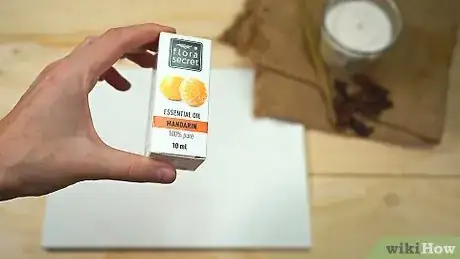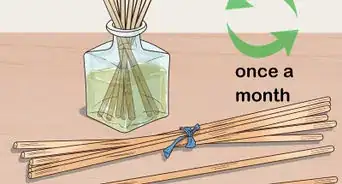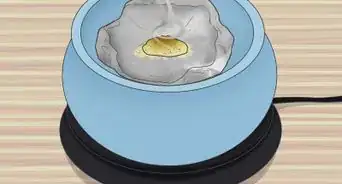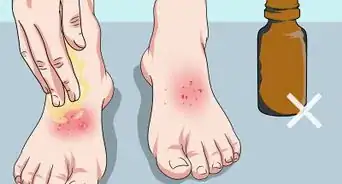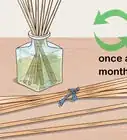This article was co-authored by Karina Klimtchuk, L.Ac., DACM, Dipl. OM and by wikiHow staff writer, Janice Tieperman. Dr. Karina Klimtchuk is a Licensed Acupuncturist, Diplomate of Oriental Medicine, Faculty Member at Yo San University of Traditional Chinese Medicine, and the Owner of Kai Wellness. She specializes in holistic health, Chinese herbal medicine, and functional medicine. Dr. Klimtchuk also helps patients through emotional and spiritual trauma. She holds a BA in Psychology and Sociology from The University of Massachusetts, Boston, a Master's from Emperor's College in Santa Monica, CA, and a Doctorate of Acupuncture and Chinese Medicine (DACM) from Pacific College of Oriental Medicine.
There are 17 references cited in this article, which can be found at the bottom of the page.
wikiHow marks an article as reader-approved once it receives enough positive feedback. In this case, 100% of readers who voted found the article helpful, earning it our reader-approved status.
This article has been viewed 439,675 times.
From religious ceremonies to aromatherapy, incense plays an important role in many cultures and settings—including your home! Incense sticks are an easy way to add a beautiful fragrance to your living space; best of all, they’re super easy to make. With just a few ingredients and materials, you can enjoy the wonderful scents of your homemade incense in a matter of days.
Things You Should Know
- Coat unscented incense sticks with your favorite essential oils to create incense in around 2 days.
- Coat your oil-soaked sticks with dipropylene glycol (DPG) to prevent your incense from giving off black smoke.
- Hand-roll your own incense sticks using powdered ingredients and water. Knead the ingredients into a dough, roll them into sticks, and let them dry for up to 5 days.
Steps
Essential Oil Incense Sticks
-
1Choose an essential oil (or oils) to use for your incense sticks. Feel free to use just one if you’d like your sticks to have a really strong scent, or mix and match a few different scents to give your sticks a fragrant blend. Some common scents for incense include:
- Wood Scents: Sandalwood, pine, cedar, juniper, pinion pine
- Herbal Scents: Sage, thyme, lemongrass, rosemary, star anise
- Floral Scents: Lavender, iris, rose, saffron, hibiscus
- Other: Orange flower, cinnamon, calamus root, frankincense, vanilla, myrrh[1]
- If you're mixing scents, start with only a few drops at a time until you get a combination you enjoy. There are very few combinations that will smell "bad," but you should still experiment to find what you like best.
-
2Use 20 drops of your essential oils for each stick you’re making. If you’re making 1 stick at a time, 20 drops will do. To prepare a small batch of 5 incense sticks, use 100 total drops of essential oils (around 4 mL). Always use premade, unscented incense sticks, which will soak up the fragrances.[2]
- If you’re preparing multiple incense sticks at once, it helps to measure out the essential oils in a graduated cylinder.
- Always wear gloves whenever you’re working with undiluted essential oils, as they can really irritate your skin.[3]
- Feel free to make lots of incense sticks at once, if you’d like! Depending on the size of your batch, you might need multiple bottles of essential oil to get the job done.
- Tip: Want to work with fragrance oils (man-made chemicals) rather than essential oils? Just fill a tall, empty bottle with your desired fragrance oil and dip your incense sticks in the liquid. Then, air-dry the sticks on a drying rack for a few hours, cover them in plastic wrap overnight, and blot them with clean paper towels the next day.[4]
Advertisement -
3Drip the oil directly onto the stick if you’re scenting 1 stick at a time. Place the blank stick in a narrow dish (like an olive tray) and drip the oil (or oils) along the thicker, absorbent portion of the stick. Try to spread out the drops rather than applying them all in one spot.[5]
-
4Soak the sticks in the oil mixture if you’re making 5 sticks at a time. Grab a narrow dish and fill it up with 100 total drops of essential oil (or a mixture of essential oils). Mix the oils together with a spoon handle so they’re well-distributed, and then place the sticks into the oil-filled dish to soak. While wearing gloves, press the sticks into the mixture to ensure that all the oil gets soaked up.[6]
- If the sticks don't fit, transfer your essential oils to a sheet of aluminum foil that’s partially folded into a V to ensure none leaks out. Make sure all the sides of the stick soak up the essential oils.
- You can also place your incense sticks in a larger container if you’re making a big batch.
-
5Place the sticks of incense end-up in a mug to dry overnight. The sticks need to dry for 10-15 hours before they can be burned.[7] As they dry, the sticks will emit a wonderful smell, meaning they will "work" for a day even if you can't burn them yet!
-
6Dip your sticks in DPG and let them air-dry. Pour dipropylene glycol (DPG) into a tall bottle and dip each stick into the liquid. Then, lay the sticks out on a cooling rack for a few hours so they can dry off completely. Soak up any leftover DPG with clean power towels before wrapping the incense in plastic wrap and giving them 1 more night to air-dry.[9]
- While you don’t have to apply DPG, it can help your incense give off less black smoke when you light it.[10]
Hand-rolled Incense Sticks (with Raw Materials)
-
1Follow a pre-made incense recipe if you don’t feel like experimenting. There are plenty of tried-and-true incense recipes made with raw materials (rather than oils) that don’t require you to mix different combinations of fragrances on your own. Some incense makers even categorize their recipes by magical properties and benefits:
- Good mojo: 4 parts palo santo, ½ part tonka beans, ½ part nutmeg, and ½ part star anise[11]
- Clarity: 2 parts aloeswood, 2 parts sandalwood, ½ part rose petals, ½ part calamus, ¼ part spikenard[12]
- Protection: 3 parts white sage, 3 parts desert sage, 1 part hyssop, 1 part lavender, 1 part bay laurel[13]
- Awareness: 2 parts sandalwood, 2 parts aloeswood, ½ part cassia cinnamon, ¼ part clove, ⅛ part of borneol camphor[14]
-
2Choose a combination of scents if you don’t want to follow a recipe. Aromatic ingredients fall into 3 categories: top notes (scents that you smell right away and disappear quickly), middle notes (scents that you smell gradually and help fill out the overall scent), and base notes (scents that last a long time and stick around in your living space). Base notes are the most important ingredients to include, but adding middle and top notes can add a fragrant complexity to your incense.[15] Here’s a quick breakdown of some common notes people use in their incense:
- Base notes: Balsam of Tolu, burgundy pitch, cassia, cedar, juniper, sage, sandalwood
- Middle notes: Basil, cinnamon, clove, lavender, lemongrass, mugwort, turmeric
- Top notes: Bay laurel, cardamom, coriander, hibiscus, nutmeg, star anise, thyme[16]
-
3Create your own incense recipe with the scents you’ve chosen. Some incense makers like to build their incense recipes in “parts,” with a single “part” representing a consistent unit of measurement, like 1-3 grams or 1 teaspoon or tablespoon. Play around with different ratios of different fragrances until you find a combo that really resonates with you.[17]
- Some incense makers suggest starting with 2-3 scents, using 1-2 tablespoons of each. Be sure to write down how much of each scent you end up using!
- You can buy your scents whole or powdered, but it’s much easier to work with pre-powdered scents.
-
4Grind your ingredients with a mortar and pestle or hand-cranked coffee grinder. Gums and resins (like balsam, burgundy pitch, hibiscus, and myrrh) need to be ground in a mortar and pestle, while wood ingredients (like cedar, pine, and sandalwood) can be powdered in a hand-cranked coffee grinder. This tool also works well for most herbs and spices, but chunkier ingredients (like cinnamon sticks and nutmeg) might need to be broken down with mortar and pestle before being hand-cranked.[18]
- It helps to freeze gums and resins for at least 15 minutes before you stick them in the mortar and pestle. If the ingredient is especially soft, leave it in the freezer overnight before grinding it down.
- Wood can be challenging to break down—it helps to break the wood into smaller pieces with a hammer before grinding them.
-
5Sift the ingredients and mix them together in a bowl. Transfer each of your freshly ground incense ingredients into a flour sifter. Then, sift the ingredients into a fine powder and mix them all together in a bowl.[19]
- Toss out any of the large chunks that don’t make it through your sifter.
-
6Pour makko powder into your incense mixture. Take a look at the ingredients you used for your incense—if they’re mostly gums and resins (like like balsam, burgundy pitch, hibiscus, and myrrh), pour in 40-90% makko powder. If your mixture includes a lot of herbs, spices, and wood-based ingredients, add 5-30% makko powder instead. All you have to do is weigh your existing incense mixture and multiply it by the makko percentage to get the exact amount of makko powder that you need.[20]
- Let’s say you have a high-resin incense mixture that weighs 25 grams total. You could multiply 25 by 0.5 (which represents 50%), which gives you 12.5. So, you’d add 12.5 grams of makko powder to your existing incense mixture.
- If you have a woody and herbal incense mixture that weighs 18 grams total, you could multiply 18 by 0.15, which gives you 2.7. So, you’d add 2.7 grams of makko powder to your woody and herbal incense mixture.
-
7Set aside 10% of your total powder mixture. Take out a small portion of your mixture and set it aside. This can help you re-thicken the incense in case you accidentally add too much water later on.[21]
-
8Add water to your mixture gradually with a pipette and knead it together. Squeeze 5-10 drops of water into your powder mixture before mashing the powders together with the back of a spoon. Keep dripping the water into the incense mixture until it resembles a dry dough that doesn’t crumble.[22] Once a firm dough starts to form, knead everything together with your hands.[23]
- If you add too much water, pour what you can out of the bowl and use your remaining powder to dry things out a bit.
- Some incense makers prefer to use distilled water.[24]
-
9Roll the dough into incense sticks. Pull off a small chunk of incense dough and turn it into a ball with your palms. Continue rolling the dough out into a long stick—it helps to use the bottom of a flat box for this, which makes the incense stick look more even. Keep rolling until you’re happy with the thickness of your stick; then, continue rolling the rest of your incense dough into sticks.[25]
- Your incense sticks can be as thin as a spaghetti noodle or nearly as thick as a wooden pencil—it really depends on your personal preference!
- If you’d like your incense to be on the thicker side, roll it so it’s slightly thinner than a pencil. If you’d prefer thinner incense, roll it so it has the thickness of a spaghetti noodle.
-
10Dry and rotate the sticks on a wax paper-lined cutting board. Set the rolled incense sticks on the cutting board. Then, place the sticks and cutting board into a paper bag and tie it shut. Over the next few days, reopen the bag and rotate the sticks slightly so they can dry completely.[26]
-
11Let the sticks dry for 1-5 days before lighting them. Once the incense doesn't droop and is no longer malleable, you're ready to use it![27] If you live in a more humid environment, it will take closer to five days. However, it might take only 1-2 days in a drier climate.
Warnings
- Always burn incense in a supervised and well-ventilated area away from pets and children.⧼thumbs_response⧽
- Never attempt to dry incense by baking or microwaving—this creates a fire hazard.⧼thumbs_response⧽
- Incense smoke irritates your lungs, so always keep your windows open and run an air purifier while you’re burning it.⧼thumbs_response⧽
Things You’ll Need
Essential Oil Incense Sticks
- Essential oils
- Unscented incense sticks
- Narrow dish (like an olive tray)
- Dipropylene glycol
- Gloves
- Mug
- Paper towels
- Plastic wrap
- Drying rack
- Foil (optional)
- Fragrance oil (optional)
Hand-rolled Incense Sticks
- Powdered incense
- Mortar and pestle
- Hand-cranked coffee grinder
- Water
- Makko powder
- Cutting board
- Wax paper
References
- ↑ https://ninonusa.com/blogs/news/how-to-make-incense-sticks-with-essential-oils
- ↑ https://www.aromahead.com/blog/make-incense-sticks-essential-oils-nl
- ↑ https://www.hopkinsallchildrens.org/ACH-News/General-News/Are-Essential-Oils-Safe-for-Children
- ↑ https://www.soywaxcandles.org/other-craft-ideas/making-incense/
- ↑ https://www.aromahead.com/blog/make-incense-sticks-essential-oils-nl
- ↑ https://www.aromahead.com/blog/make-incense-sticks-essential-oils-nl
- ↑ https://www.aromahead.com/blog/make-incense-sticks-essential-oils-nl
- ↑ https://ninonusa.com/blogs/news/how-to-make-incense-sticks-with-essential-oils
- ↑ https://www.soywaxcandles.org/other-craft-ideas/making-incense/
- ↑ https://planetmeditate.com/how-do-you-make-incense-sticks-last-longer/
- ↑ https://incensemaking.com/recipes/magical/luck/
- ↑ https://incensemaking.com/recipes/magical/healing/
- ↑ https://incensemaking.com/recipes/magical/protection/
- ↑ https://incensemaking.com/recipes/emotional/meditation/
- ↑ https://incensemaking.com/recipes/magical/luck/
- ↑ https://incensemaking.com/aromatics/
- ↑ https://incensemaking.com/recipes/magical/luck/
- ↑ https://incensemaking.com/how-to-make-incense/
- ↑ https://incensemaking.com/how-to-make-incense/sticks-cones-molds-trails/
- ↑ https://incensemaking.com/how-to-make-incense/sticks-cones-molds-trails/
- ↑ https://incensemaking.com/how-to-make-incense/sticks-cones-molds-trails/
- ↑ https://learningherbs.com/remedies-recipes/how-to-make-incense/
- ↑ https://incensemaking.com/how-to-make-incense/sticks-cones-molds-trails/
- ↑ https://albuquerqueherbalism.com/2020/08/02/make-incense-inspire-wisdom-invite-blessings/
- ↑ https://incensemaking.com/how-to-make-incense/sticks-cones-molds-trails/
- ↑ https://incensemaking.com/how-to-make-incense/sticks-cones-molds-trails/
- ↑ https://incensemaking.com/how-to-make-incense/sticks-cones-molds-trails/
- ↑ http://www.greatcandle.com/assets/images/Incense%20Stick%20Instructions%20and%20Information.pdf
- Videos provided by Andrea Butje
About This Article
To make your own incense sticks, start by purchasing a set of unscented incense sticks and 1 or more of your favorite essential oils. Next, mix 20 drops of oil per incense stick in a shallow dish and place up to 5 sticks in the dish. Then, turn and gently press the sticks in the oil until all of the oil is absorbed into the sticks. Afterwards, place the sticks incense end up in a mug or cup, and let them dry for 12 to 15 hours before burning. To learn more, including how to make hand-rolled incense sticks with herbs and spices, read on.
